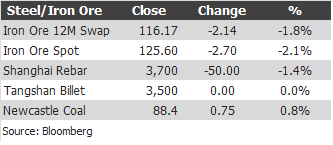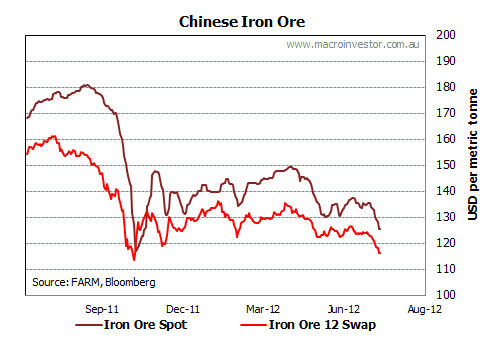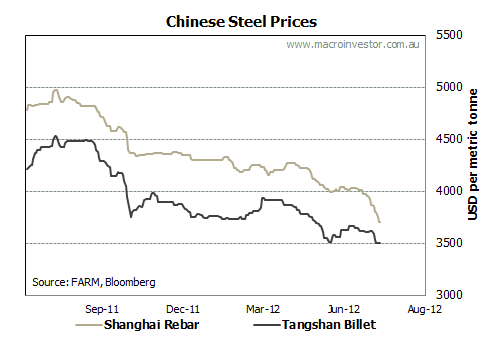A few months ago I investigated the growing the divergence between a weak thermal coal price and strong iron ore as well as coking coal commodity markets. The divergence continues but the relative strength has reversed. Here are the overnight prices:

The bounce from the recent lows for thermal coal is not yet convincing:

Thermal coal demand is less China centric than coking but China is still the marginal buyer. There is hope in its recent coal shipping indexes but it’s still too early to say:

Now to the weakening component. Here’s is the chart for iron ore and 12 month swaps:

The broken support I identified earlier in the week has led to an accelerating move down. Iron ore is now within a whisker of its argued fundamental support at $120 and futures are closing in on a new cycle low. I expect both to break.
And here is why, Chinese steel prices are still falling:

Both Shanghai rebar and Tangshan billet are weak with no end in sight. There’s little hope in the Chinese coastal bulk shiping index either:

Clearly, either demand for Chinese steel is off a lot or there is a glut of the stuff lying around, or both.
There is better news in coking coal which is holding just below $220, where it has been for several months. But if iron ore keeps sliding it is surely only a matter of time.
If you’d asked any economic grey-beard over the past few years why the dollar has been so strong they would have told you that the main reason was the iron ore price. Combined with coking coal, the two make up around 40% of the terms of trade and are, really, the commodities boom that underpins the dollar.
But if you look at an AUD versus iron ore spot chart, you will see that that relationship is breaking, and fast:

The brown and green lines are the 200 day moving averages. You can see the nice correlation post GFC and the more recent widening departure.
It is well documented that the strength in the dollar is now based upon a number of other factors, including mining capital inflows, as well as financial flows from reserve banks and carry traders, but to my mind, so long as iron ore falls away like this, the dollar is departing from fundamentals.

